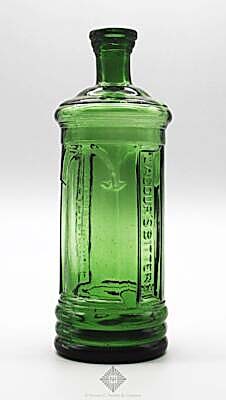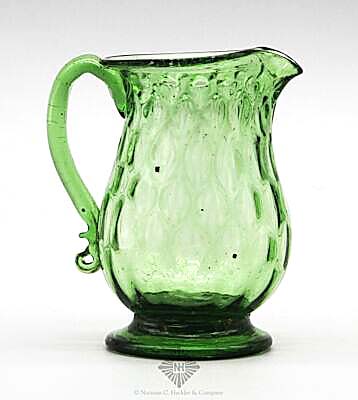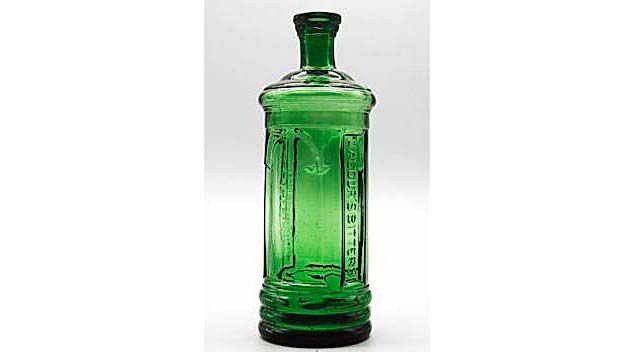#Heckler #Glass #Auction #Celebrates #Classic #Forms #Discoveries #Antiques #Arts #Weekly

This “Lacour’s Bitters” 9-inch-tall figural bottle, “Sarsapariphere,” 1860-70, which realized $28,080, was the top lot in the sale. It had a modified lighthouse form, cylindrical with sunken side panels. The color was bright grass green with a hint of lime, and it featured an applied triple collared mouth and smooth base.
Review by W.A. Demers
WOODSTOCK VALLEY, CONN. — Norman Heckler, Jr, presented a select group of 31 choice examples of glass bottles in his firm’s online sale that ran from September 19-25. The sale totaled $207,300 with just one lot passed and with 179 registered bidders participating on Heckler’s own platform.
Among the celebrated classics and new discoveries were early American glass, fine tableware, historical flasks and bottles.
The top lot in the sale was a “Lacour’s Bitters” figural bottle, “Sarsapariphere,” circa 1860-70, which realized $28,080. It presented a modified lighthouse form, cylindrical with sunken side panels. Its color was bright grass-green with a hint of lime, and it featured an applied triple collared mouth and smooth base. At 9 inches tall, it was, per catalog note, “clean and bright, handsome color, excellent condition. A rare figural bottle thought to have been manufactured in San Francisco, Calif.”
“It went to a collector,” said Heckler. “This type of bottle is favored more by the West Coast collectors. It’s a so-called ‘Western’ bottle. All the ones that we’ve sold tend to go out to the West Coast.”

The salient feature of this rare miniature Pitkin flask deaccessioned from the Suffield, Conn., Historical Society to benefit its collections fund were the partial paper label fragments on front and back. Its final price of $24,570 surpassed its $3/5,000 estimate. Ribbed and swirled the 3-5/8-inch-high New England example, 1783-1830, presented shades of yellow and olive in coloration, with a tooled mouth and tubular pontil scar.
A miniature Pitkin flask deaccessioned from the Suffield, Conn., Historical Society to benefit its collections fund, stirred up a final price of $24,570, surpassing its $3/5,000 estimate. Ribbed and swirled — 36 ribs to be precise — the 3-5/8-inch-high New England example, 1783-1830, presented shades of yellow and olive in coloration, with a tooled mouth and tubular pontil scar. A bonus for historical glass bottle collectors were historic paper label fragments on front and back: “William R. Preston Apothecary, 2 Congress Block, Congress St., Portsmouth, New Hampshire.”
“That helped a lot,” said Heckler of the partial labels. “There’s just a handful of Pitkin glass miniatures. It did very, very well.”
Fetching $12,870 was a “Lafayette” and bust, Masonic arch and emblems portrait flask by Coventry Glass Works, Coventry, Conn., 1824-25. Featuring a portrait of the American Revolution’s famous French ally, the pint bottle was a brilliant yellow olive color with sheared mouth and pontil scar. It was referenced in American Bottles & Flasks and Their Ancestry by Helen McKearin and Kenneth M. Wilson (Crown Publishing, New York City, 1978). Cataloging describes it as an “exceptional example in mold definition and color.” There were four Lafayette flasks in this sale. “This particular one had the Masonic emblem on the back,” commented Heckler, “and that combination with Lafayette is rarer. It’s interesting to note that this year is the 200th anniversary of Lafayette’s farewell tour in America. Also, he was a Mason and he received more Masonic honors than any freemason since.”

Gilbert du Motier, Marquis de Lafayette (1757-1834) was a freemason, a fact that was catnip to Lafayette type bottle collectors in this 200th anniversary year of the farewell tour of the American Revolution’s famous French ally. With “Lafayette” bust, Masonic arch and emblems, this pint portrait flask by Coventry Glass Works, Coventry, Conn., 1824-25, sold for $12,870. It was a was a brilliant yellow olive, with sheared mouth and pontil scar.
Square with beveled corners and fancy cathedral arches and in an unusual sage green, a Cathedral pickle jar jumped its $4,000 high estimate to finish at $10,530. It was made by the Willington Glass Works, West Willington, Conn., 1845-60. At 11¼ inches high, its rare color and fine condition factored into its good performance.
A new discovery was characterized as a great piece of early American glass with a large presence. It was a free-blown pitcher in golden amber from Zanesville, Ohio, 1820-40, that made $7,605. Its broad-shouldered, tapered form sported an applied solid strap handle; its height was 6¼ inches and body diameter of 5 inches. “For years it was in the bathroom of a residence in New Hampshire,” Heckler explained. “Holding potpourri or flowers.”
A great rarity in early glass tableware that was once in the personal collection of Maud B. Feld, Manhattan antiques dealer and expert on early American glassware, was a Stiegel-type pattern molded creamer that sold for $7,020. According to Kovels.com, William Stiegel, an immigrant to the colonies, was one of the most famous makers of early-period American glass. He started his first factory in Pennsylvania in 1763 and remained in business until 1774. In the 14-diamond pattern, the creamer had a bulbous form flaring to its rim with an applied solid handle. In a brilliant lime green, it stood 3¼ inches high. “These creamers often come in blue,” said Heckler. “This one is unusual, it may even be unique in unusual color.”

Once in the personal collection of Maud B. Feld, Manhattan antiques dealer and expert on early American glassware, this Stiegel-type pattern molded creamer sold for $7,020. Kovels says that William Stiegel, an immigrant to the colonies, was one of the most famous makers of early-period American glass. This creamer was in the 14-diamond pattern, with a bulbous form flaring to the rim and an applied solid handle. In a brilliant lime green, it stood 3¼ inches high.
What could be considered a “tall drink of glass,” was a monumental free-blown vase by the Boston & Sandwich Glass Works, Sandwich, Mass., 1840-70. Its elongated neck with fluted trumpet mouth and inward rolled rim, quadruple knop stem and circular foot were complemented by a deep amethyst color. Very few examples are known of this trumpet vase form in an extremely large size, noted the catalog of the 16¼-inch-high vase. “We were exceptionally pleased,” said Heckler.
Prices given include the buyer’s premium as stated by the auction house. No date has been posted for Heckler’s next sale. Heckler said it would be sometime in the late fall. For information, www.hecklerauction.com or 860 974-1634.




